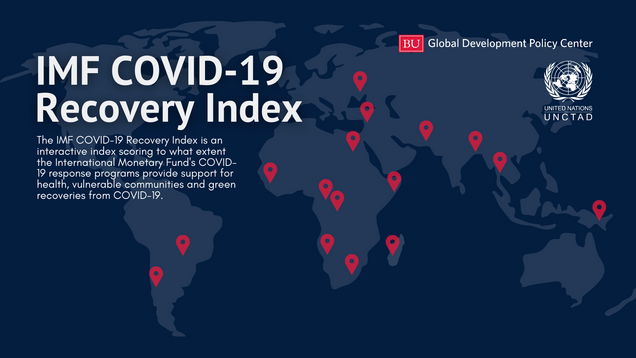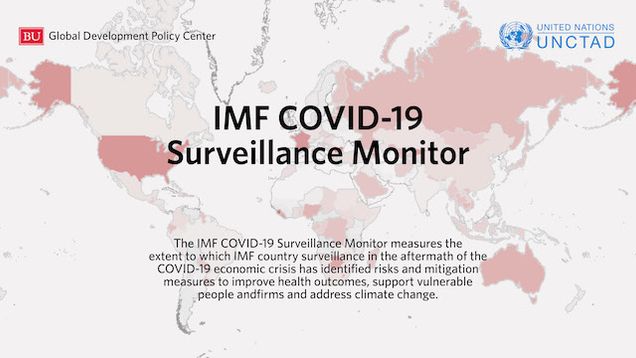Data Analysis for Transparency and Accountability: Tracking the COVID-19 Recovery

As the more lethal and contagious Delta variant of COVID-19 spreads across the globe, concerns continue to mount about the duration of the global pandemic and its growing social and economic costs. Just last week, the International Monetary Fund (IMF) trimmed its global economic growth forecast and cited rising debt levels and vaccine inequity as key obstacles to a balanced recovery. Advanced economies and China are experiencing improvements in overall economic conditions, as high vaccinations rates and other public health measures help mitigate the impacts of COVID-19. In stark contrast, the vast majority of the world remains mired in a public health crisis that has decimated many countries’ economies.
What is more, as advanced economies and China continue to see their economies recover and COVID-19 subside, accelerated economic growth could lead to interest rate increases that trigger capital outflows and exchange rate depreciation in low- and middle-income countries. This could balloon external debt and further exacerbate what is already a divergent recovery between the advanced economies and China, and the rest of the world.
Against this backdrop, it is more important than ever for the IMF and other components of the Global Financial Safety Net (GFSN) to rise to the moment. In April 2020, the IMF Managing Director, Kristalina Georgieva, stressed that “exceptional times call for exceptional action.” More recently in September 2021, the IMF Fiscal Affairs Department underscored the need to support health systems, protect vulnerable people and firms and build a resilient recovery to climate change.
At the Boston University Global Development Policy (GDP) Center, the Global Economic Governance Initiative (GEGI) has developed a series of interactive trackers to monitor the COVID-19 crisis response and recovery. Throughout the pandemic, these interactives have proven to be sources of vital public information for policymakers, reporters, researchers, civil society, students and others to explore and draw insights on the crisis and recovery process. Throughout the pandemic, these interactives are updated quarterly, as GEGI researchers seek to provide transparent and accessible information to monitor, track and aid the global economic recovery effort.
New updates to the trackers were launched in October 2021. See highlights from the latest releases below:
Global Financial Safety Net Tracker
![]() The Global Financial Safety Net Tracker, comprised of two components, allows users to explore and track the global financial agreements and short-term crisis finance that make up the GFSN. The first component of the interactive displays the total amount of financing provided by the IMF, regional financial arrangements (RFAs) and central bank bilateral currency swaps deployed to combat the COVID-19 crisis. Country specific data, approved loan amounts, RFA membership and country income group information are available for highlighted countries within the interactive. The COVID-19 tracking source is the first of its kind that regularly updates overviews of all RFA loans and central bank currency swaps disbursed in response to the COVID-19 crisis. A recently updated feature allows users to visualize the directionality of swap flows from the lending to borrowing countries. The second component of the interactive is the GFSN Annual Lending Capacity, where countries are color-coded based on the lending capacity available to them through the IMF, RFAs or central bank currency swaps.
The Global Financial Safety Net Tracker, comprised of two components, allows users to explore and track the global financial agreements and short-term crisis finance that make up the GFSN. The first component of the interactive displays the total amount of financing provided by the IMF, regional financial arrangements (RFAs) and central bank bilateral currency swaps deployed to combat the COVID-19 crisis. Country specific data, approved loan amounts, RFA membership and country income group information are available for highlighted countries within the interactive. The COVID-19 tracking source is the first of its kind that regularly updates overviews of all RFA loans and central bank currency swaps disbursed in response to the COVID-19 crisis. A recently updated feature allows users to visualize the directionality of swap flows from the lending to borrowing countries. The second component of the interactive is the GFSN Annual Lending Capacity, where countries are color-coded based on the lending capacity available to them through the IMF, RFAs or central bank currency swaps.
According to estimates compiled by the GDP Center and the Latin American Institute at Freie Universität Berlin, the financing available from the GFSN has reached nearly $3.5 trillion, compared to the IMF’s $1 trillion lending capacity. However, distribution and availability of these emergency funds has been highly uneven and unequal. According to researchers, there is an urgent need to coordinate the different elements of the GFSN to improve country access to vital fiscal resources. Explore the interactive and read the policy brief.
IMF COVID-19 Recovery Index
 Between March 2020 and July 2021, the IMF approved $57.2 billion for programs in over 122 countries, emphasizing support for public health, protecting vulnerable people and a green recovery. The IMF COVID-19 Recovery Index assesses this global economic recovery process, calculating a composite score for each IMF country program, or borrowing country, based on three equally weighted scores in the aforementioned areas.
Between March 2020 and July 2021, the IMF approved $57.2 billion for programs in over 122 countries, emphasizing support for public health, protecting vulnerable people and a green recovery. The IMF COVID-19 Recovery Index assesses this global economic recovery process, calculating a composite score for each IMF country program, or borrowing country, based on three equally weighted scores in the aforementioned areas.
While many IMF programs are encouraging emergency measures for public health and the protection of vulnerable people, efforts in greening the recovery have so far been limited. For example, the Index shows that IMF COVID-19 response programs for 86 of 122 programs do not address climate change, or green recovery efforts at all. The impacts of these shortcomings will reverberate throughout national and international recovery efforts for decades to come. That said, the most recent update to the data reflects that the IMF has put more emphasis on analyzing and making recommendations regarding climate change policies in 17 newly analyzed programs. The green recovery score for the newly analyzed programs was 1.80, with 10 of the 17 new programs receiving recommendations or conditionalities related to the green recovery pillar. Explore the interactive and read the journal article.
IMF COVID-19 Surveillance Monitor
 The IMF COVID-19 Surveillance Monitor measures the extent of the IMF’s attention to health outcomes, support for vulnerable people and firms and climate change before and during the COVID-19 pandemic. The interactive tracks and displays the frequency of topic mentions of these issue areas in IMF in-country assessments, known as Article IV consultations.
The IMF COVID-19 Surveillance Monitor measures the extent of the IMF’s attention to health outcomes, support for vulnerable people and firms and climate change before and during the COVID-19 pandemic. The interactive tracks and displays the frequency of topic mentions of these issue areas in IMF in-country assessments, known as Article IV consultations.
Previously, the IMF gave relatively little attention to health, support for the vulnerable and climate change in its surveillance work. However, Article IV consultations conducted during COVID-19 shifted significantly and increased attention towards supporting public health and vulnerable people, but attention to climate change has remained minimal. As countries work to recover from the COVID-19 pandemic, a regular review of IMF surveillance guidelines will aid ongoing efforts to examine the IMF’s measures and advice for better post-COVID-19 outcomes.
In October 2021, new data was uploaded to the Monitor to better understand how IMF surveillance mechanisms identify the risks and mitigation tools available to countries in the aftermath of the COVID-19 crisis. Originally, the Monitor relied on five categories: health (including COVID-19), support for the vulnerable, climate change and fiscal consolidation. The new Monitor update separates the “health” and “COVID-19” grouping, graduating pandemic-related issues to its own category given the scope of the crisis.
The updated data reflect a continued increase in engagement on climate issues and health in Article IV reports during 2020 and 2021. However, following gains in 2020, support for the vulnerable lost momentum and decreased in 2021. The IMF revised guidance on bilateral surveillance and the Comprehensive Surveillance Review (CSR) integrated macro-critical trends, such as climate. That said, the Fund should adapt its tools and resources to the current global challenges by incorporating climate risks cohesively and comprehensively into its analysis. Explore the data and read the working paper.